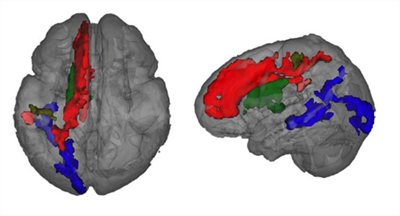Toddlers' brain-wiring develops to accommodate new words
Researchers from King’s College London and Brown University (US) have identified how the ‘wiring’ in toddlers’ brains develops to successfully learn language. The study reveals a particular window, from 2 years to the age of 4, during which environmental influence on language development may be greatest.
The findings help explain why, in a bilingual environment, very young typically developing children are better capable of becoming fluent in both languages; and why interventions for neurodevelopmental disorders where language is impaired, such as autism, may be much more successful if implemented at a very young age.
Children develop from a limited vocabulary of up to 50 words at the age of one to a vocabulary of approximately 5,000 words by the age of 6. In order to investigate the brain anatomy that develops to support this intense linguistic development, a team of researchers studied 108 typically developing children between the ages of 1 and 6 years old. They used a novel magnetic resonance imaging (MRI) method to determine the levels of a substance called ‘myelin’ and its distribution across the two hemispheres of the brain, known as ‘myelin asymmetry.’
The study is published today in The Journal of Neuroscience.
Myelin is a substance that surrounds the axons of a neuron, allowing it to communicate much more efficiently with other neurons. People are born with very little myelin but it develops rapidly after birth in response to environment and neuronal activity. The human brain is asymmetric for certain abilities and language, for example, tends to be localised on the left side of the brain – in areas at the front of the brain (frontal and temporal lobes).
Most children pick up language effortlessly, and at an incredibly fast rate. The researchers hypothesised that much more myelin would develop on the left side of the brain and that this asymmetry would continue to get stronger as children learned language.
In fact, they found that the asymmetry remained relatively constant no matter what age the children were. However, they found that the influence of this asymmetry on language ability changed with time – suggesting an age-specific influence of brain structure and myelin on language function.

Regions of the brain that show leftward asymmetry of myelin (credit: Baby Imaging Lab/Brown University)
Dr Jonathan O'Muircheartaigh, lead author from the Department of Neuroimaging at King’s College London's Institute of Psychiatry and Sir Henry Wellcome Postdoctoral Fellow, says: “Our study shows that regions of the brain that weren't important to successful language in toddlers became more important in older children, about the time they start school. As language becomes more complex and children become more proficient, it seems as if they use different regions of the brain to support it.”
The relationship between language ability and asymmetry of myelin stabilized at 4 years, indicating anatomical evidence for a critical time during development before which environmental influence on cognition may be greatest.
Dr O'Muircheartaigh adds: “We found that between the ages of 2 and 4 myelin asymmetry doesn’t predict language very well. So, if it’s not a child’s brain anatomy predicting their language skills, this means their environment might be more influential. For example, when children are immersed in a bilingual environment before the age of 4, they are much more likely to become fluent in both languages, with no hint of an accent.”
The researchers explain that increasing our understanding of typical brain growth patterns of myelination and asymmetry may help shed light on if, where and when this process of myelination is going off track in disorders where language is altered or delayed, such as autism, ADHD and dyslexia. The window identified in this study suggests that any interventions aimed at improving language-related symptoms of these disorders would need to take place very early on, before the age of 4.
Dr Sean Deoni, senior author of the study from Brown University, says: “This work is important as it is the first to investigate the relationship between brain structure and language across early childhood and demonstrate how this relationship changes with age. This is important since language is commonly altered or delayed in many developmental disorders, such as autism. Our work highlights the advantage of collaborative work, combining expertise in paediatric imaging at Brown and neuropsychology from King’s, making this work possible."
The study was funded by the National Institutes of Mental Health (US) and the Wellcome Trust (UK).
Paper reference: Jonathan O'Muircheartaigh et al.: "Interactions Between White Matter Asymmetry and Language During Neurodevelopment" The Journal of Neuroscience (October 2013) DOI:10.1523/JNEUROSCI.1463-13.2013
For further information, please contact: Seil Collins, Press Officer, Institute of Psychiatry, King’s College London Seil.collins@kcl.ac.uk / (+44) 0207 848 5377